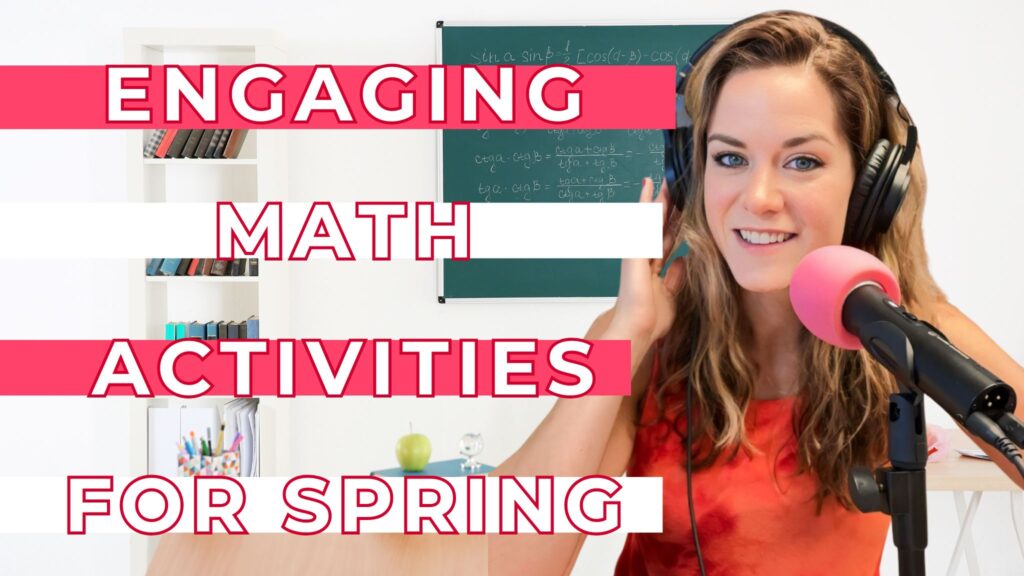What if your students could get outside, soak up the sunshine, and still hit your learning goals in math with fun math activities?
Let’s be honest—when spring hits, no one wants to be stuck inside completing packets. (Freakin’ packets, amiright?!) The good news? You can take math outdoors with purpose and still keep things rigorous and aligned.
In this episode of The Modern Math Teacher Podcast, I’m sharing two of my favorite hands-on math activities designed for the great outdoors. These projects are the perfect mix of movement, engagement, and math mastery—ideal for spring energy and end-of-year wrap-up.
🎧 Listen to the Episode Here
📺 Watch on YouTube Here
Why Outdoor Math Is a Win-Win
🌞 Spring is the season of restlessness. Students are craving movement, and honestly—so are we. Taking math outside gives everyone a break from the walls without taking a break from learning.
Here’s why outdoor math activities are so powerful:
✅ Movement = focus. A quick change of scenery improves attention and energy.
✅ Outdoor settings make math real. Math didn’t start in textbooks—it started in the real world. So let’s get back outside and see it in action.
✅ You can still hit key standards. With intentional planning, you can cover everything from graphing to trigonometry outside!
If you’re looking for STEM math activities that feel fresh but still serve a purpose, you’re going to love these.
Project Spotlight #1: Rocket Launch (Quadratic Functions)
🚀 This one is a classic for a reason. Students love the Rocket Project.
In this hands-on math activity, students build and launch water-powered rockets. They then model the height of the rocket using quadratic equations.
📈 Standards covered:
- Graphing parabolas
- Analyzing vertex, intercepts, domain, and range
- Applying the structure of quadratic functions to real data
It’s perfect for Algebra 1 or Algebra 2—and all you need is a little open space and some clipboards. Trust me, students will beg to do this one again.
Read more about my Favorite Project of the Year
Project Spotlight #2: Kite Geometry Project (Cumulative Review)
🪁 This is one of my favorite math activities for middle schoolers and high schoolers, especially for wrapping up a Geometry unit.
Students design, build, and fly kites—applying everything they’ve learned about:
- Quadrilaterals and their properties
- Triangle similarity and congruence
- Trigonometry (including angle of elevation & right triangle relationships)
After building and flying their kites, students collect data and calculate the height using trig and proportions. It’s a perfect end-of-unit project or alternative assessment that mixes creativity, math reasoning, and real-world application.
“My students were so proud of their kite creations—and didn’t even realize they were doing trigonometry outside!”
Read More about this Quadrilateral Project and PBL
Bonus Ideas for Outdoor Math Activities
Want even more ways to get outside and keep students engaged?
Try one of these:
🟣 Sidewalk chalk graphing – Have students graph linear or quadratic equations directly on the blacktop. Bonus idea: draw parallel lines and transversals to review angle relationships.
🟣 Math scavenger hunts – Create a series of math clues based on coordinates, geometry, or problem-solving. Send them on a geo-style hunt!
🟣 Photography math walks – Assign students to find and photograph real-world examples of math concepts like symmetry, angles, proportions, or transformations.
All of these work beautifully as STEM math activities and can easily be adapted for different grade levels or standards.
Grab the Projects Featured in This Episode
Want the done-for-you versions of the Rocket and Kite Projects? You can grab them here:
🚀 Rocket Project – Quadratic Functions & Graphing
🪁 Kite Geometry Project – Trig, Similarity & Quadrilaterals
These are ready-to-print, standards-aligned, and tested by teachers who know the power of getting students outside and active.
Spring is the perfect time to bring new energy to your math classroom. These fun math activities for high schoolers and middle schoolers will get your students learning, collaborating, and exploring—while enjoying the fresh air.
Until next time,
Keep it hands-on, keep it real-world, and as always… keep it real.









